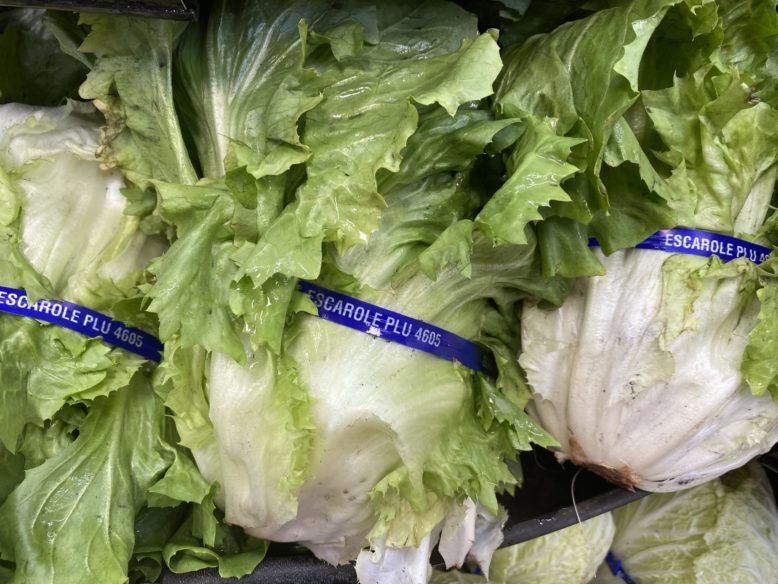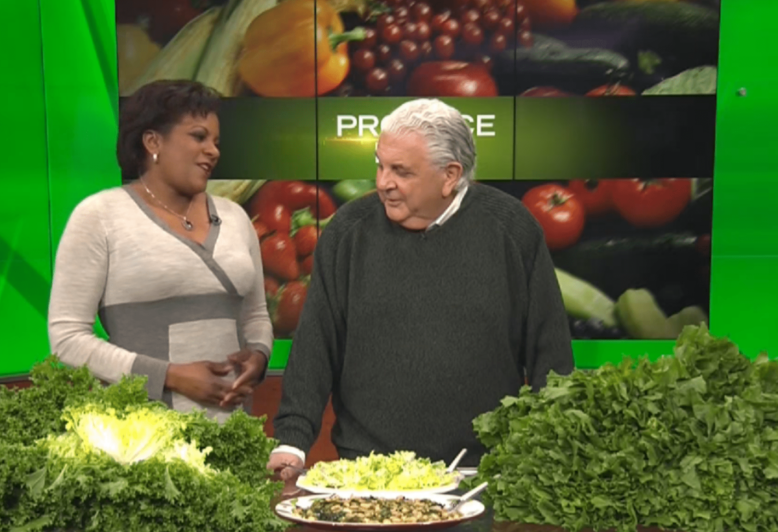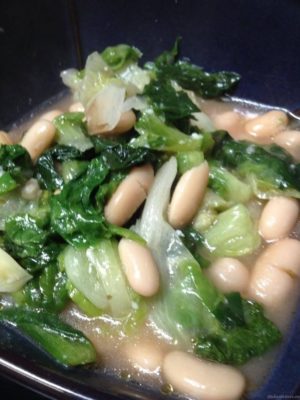
My parents opened our family business, Napolitano’s Produce in Bergenfield, in 1959, and in the back of our store we had a stove that my mom, Louise, used to cook meals for all of us and our help during the day. Her sizzling pans of escarole and beans would smell so good throughout the store that customers would ask for my mom’s recipes and then buy the ingredients. Mom was a true original and definitely ahead of her time when it came to utilizing the power of cooking demos to sell products!
Her delicious cooking won me over as well and one of my all-time favorite dishes is the simple combination of escarole, beans, and seasonings. When I was a kid, my mom used to let me and my younger brother David choose whatever we wanted for our birthday dinners. I remember that David would choose steak or leg of lamb, but no matter what, I always chose escarole and beans—leading Mom to joke that she loved to feed me because I was the cheap date in the family! To this day, even though I can afford steak and lobster, I’d rather have a plate of escarole and beans just like my mom used to prepare it.
All About Escarole and Chicory

Produce Pete discusses escarole and shares a plate of his favorite escarole and beans with anchorwoman Pat Battle during a recent segment on NBC Weekend Today in New York. Photo courtesy of Pete Napolitano/NBC
Part of the broad family of Asteraceae, escarole and chicory are basically two varieties of the same plant, but they have different shapes and uses. Although they’re not true lettuces, their leafy heads are usually found alongside lettuces at the market.
Chicory—sometimes called curly endive, and known simply as endive in Europe (despite not being the same thing as Belgian endive)—has a wild-looking, spreading head, with long, slender, very curly notched leaves. By contrast, escarole leaves are a bit broader and flatter than chicory leaves and have a smoother edge; the outer leaves are a fairly dark green but get paler towards the inside of the head and the heart is nearly white and has a semisweet flavor. Both escarole and chicory are zesty, bitter greens. Chicory is almost always consumed raw, while escarole can be eaten cooked or raw. Escarole is less bitter than other chicories and the level of bitterness varies throughout the head, with the inner, lighter-colored leaves being less bitter then the outer, darker leaves. Escarole and chicory are available year-round in New Jersey, typically grown locally in the summer and sourced from Florida and California during the winter and spring months.
Popular in Italian cuisine, escarole and chicory are high in fiber, vitamins A and C, and folate, which helps the body make healthy red blood cells. Pound for pound, escarole and chicory pack two to three times more of those nutrients for the same weight as iceberg lettuce, so they’re a great dietary choice!
Selection and Storage
When selecting escarole, look for green outer leaves with a white-to-yellow center. The butt end should be white-to-light brown and the leaves should be free of wilt and decay. For use raw in a salad, the inner, lighter-colored leaves are a good choice, while the outer green leaves are good for cooked dishes.
The rules for selecting chicory are exactly the same as escarole, but the outer leaves should be very crispy and sharp. Chicory is mostly eaten raw, never cooked.
Store escarole and chicory as you would lettuce, in the refrigerator in the crisper drawer or in a plastic bag. Both varieties keep reasonably well—up to a week—when properly refrigerated.
Preparation
Both escarole and chicory can be sandy, so wash the leaves well before using them. The outer leaves of escarole, which are relatively bitter, are the ones to use for cooking. They’re delicious added to soups, cooked with noodles, or mixed with lettuce to top Mexican dishes like tacos and burritos, and the sweeter inner leaves are very good in salads.
Chicory is a zesty, attractive addition to other greens, including bitter greens, for salad and it’s also the unique ingredient in chicory coffee, which is popular in New Orleans. The secret is actually underneath the plant—the chicory root—which is the part that gets roasted and ground into coffee.
As mentioned before, escarole is also the starring ingredient in my favorite dish, escarole and beans. I know you’ll enjoy my mother’s simple but oh-so-tasty recipe, just the same way I have for 76 years!
Mama Louise’s Escarole and Beans
(Serves 6)
Ingredients:

Bette Napolitano’s escarole and beans, one of Produce Pete’s all-time favorite dishes. Photo courtesy of Pete Napolitano
2 heads escarole
¼ cup olive oil
4 cloves garlic, chopped
2 cans cannellini beans
½ teaspoon hot red crushed pepper
Salt and pepper, to taste
Instructions:
Cut bottom core off escarole and rinse leaves well. In a large pot, put in escarole leaves and add 4 cups of water; steam until leaves are tender. Drain in colander and set aside. Place olive oil and garlic in the same pot and sauté garlic until golden brown. Add escarole and the remaining ingredients into the pot and stir. Heat thoroughly, serve, and enjoy!
About “Produce Pete” Napolitano
With over 65 years of experience in the produce industry, New Jersey’s own “Produce Pete” Napolitano is a renowned fruit and vegetable expert, author, and television personality who’s appeared on a highly-popular segment on NBC’s Weekend Today in New York broadcast every Saturday mornings for over 27 years. For more information, visit Pete’s website.
About Susan Bloom
A contributor to New Jersey Monthly and a variety of other well-known local and national publications, Susan Bloom is an award-winning New Jersey-based freelance writer who covers topics ranging from health and lifestyle to business, food and more. She’s collaborated with Produce Pete on a broad range of articles for more than a decade.
